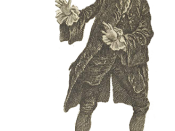In Hamlet, Shakespeare uses the images to relate the play with a greater impact and a mystery of hidden meanings. Among the images Shakespeare uses are that of death, mainly the deaths of Old Hamlet, Polonius, Ophelia, Laertes, and Hamlet himself, respectively--all of which highlights the tragedy that Hamlet suffers; and diseases to portray the deterioration/corruption not only of Denmark but also of the emotional and moral decay of the characters.
The play is set just two months after the death of the Old Hamlet. In the beginning of the play, Death comes to Denmark as the Ghost of Hamlet's dead father appears to Marcellus, Bernardo and to Horatio. "MAR: Look where it comes again./BER: In the same figure like the king that's dead./HOR: "Or if thou hast uphoarded in thy life/For which, they say, you spirits oft walk in death,/Speak of it." (Shakespeare 4, 6) The "son" of Death, so to speak, follows Death in Denmark, when Hamlet enters the scene in his "customary suits of solemn black."
(10) Later on, the Ghost, the Death, appears to its "son," Hamlet (ironically, the Ghost is in fact, Hamlet's real father), and imparts the truth (of his death) to his son. According to the Ghost himself, his death, in effect, makes two things possible: his wife Gertrude "breaks free" from her marriage to the Old King, which enables Claudius, his brother and murderer, to marry her; and for Claudius to ensure himself of the Danish crown. These two things, therefore, provide the focal point of the play. The young Hamlet is given a valid reason to be mad or to "feign" madness in order to avenge his father's murder. (Death in Hamlet)
Being the son of Death, it is no wonder then that Hamlet is so absorbed and fascinated...


